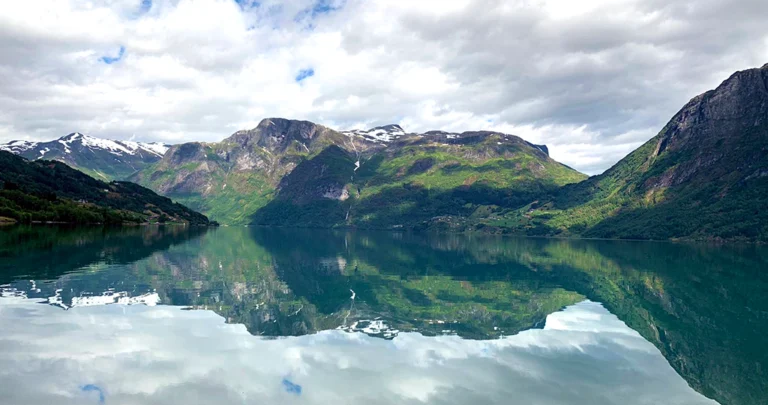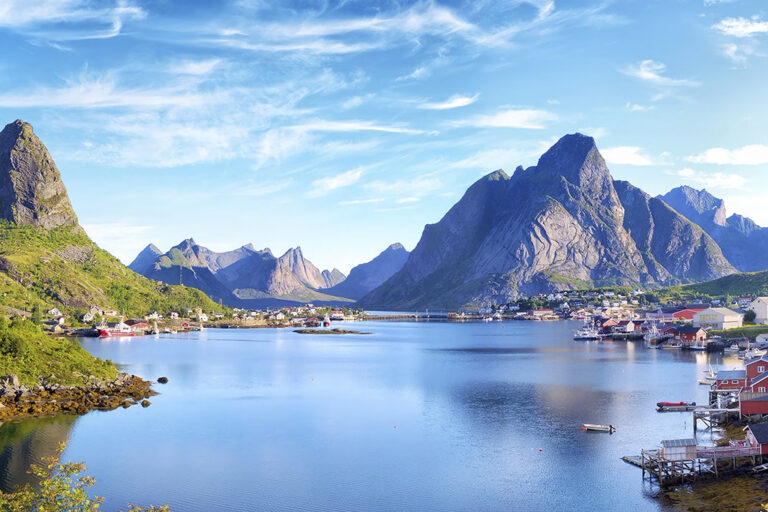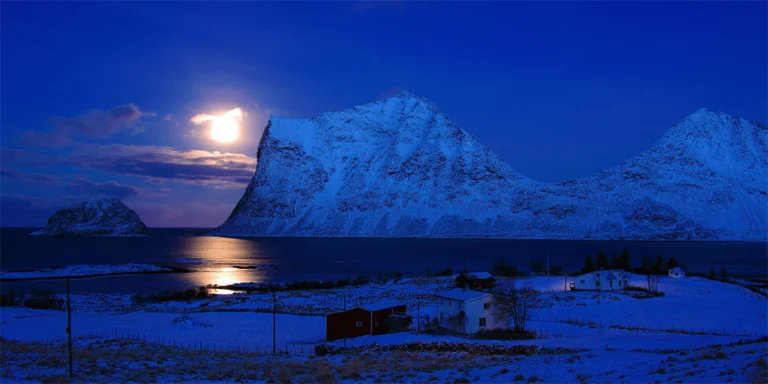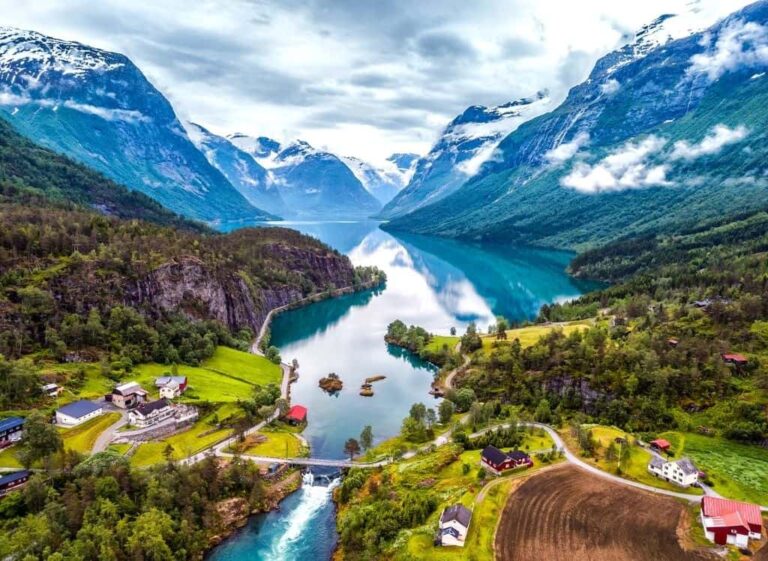Exploring Norway’s Majestic Fjords: The Ultimate Travel Guide
Introduction to Norway’s Fjords
Why Norway’s Fjords are a Must-Visit
Norway’s fjords are like nature’s cathedrals, carved by glaciers and filled with green mountain colored waters. They offer a peaceful escape from everyday life, making them a must-visit for any nature lover. The fjords are not just about the stunning views; they show the power of nature and its ability to create beauty. Imagine standing at the edge of a fjord, with tall cliffs on either side and deep blue water stretching out before you. It’s a sight that stays with you long after you’ve left.

The Geology Behind the Fjords
These majestic fjords were formed during the Ice Age when glaciers carved deep valleys into the landscape. As the glaciers melted, seawater filled these valleys, creating the stunning fjords we see today. The process took thousands of years, and the result is a landscape that is both rugged and serene. The fjords are a living history lesson, showing us the power of natural forces and the passage of time. The geology of the fjords is fascinating, with layers of rock that tell the story of the Earth’s past. It’s like reading a book written in stone, with each layer revealing a different chapter.
Must-See Fjords in Norway
Nærøyfjord: The Narrow Wonder
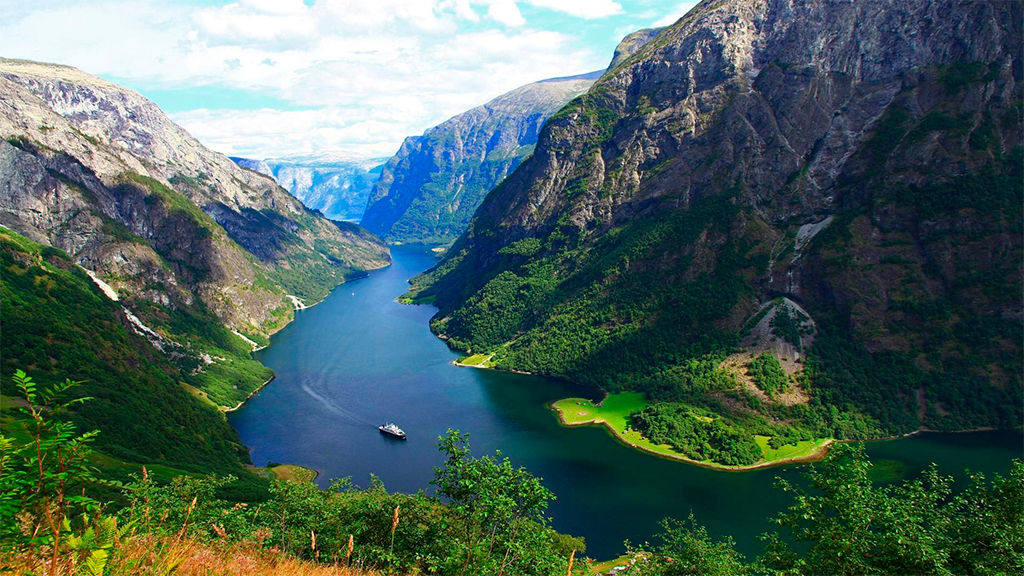
Location and Accessibility
Nærøyfjord is located in the Sogn og Fjordane region, easily accessible from the town of Flåm. It’s one of the narrowest fjords in Norway, making it a unique and breathtaking sight. The fjord is about 17 kilometers long and only 250 meters wide at its narrowest point. Despite its remote location, Nærøyfjord is surprisingly accessible. You can reach it by car, bus, or even by boat. The journey to Nærøyfjord is an adventure in itself, with winding roads and stunning views at every turn.
Unique Features of Nærøyfjord
This fjord is a UNESCO World Heritage Site, known for its sheer cliffs, cascading waterfalls, and tranquil waters. It’s a paradise for photographers and nature lovers alike. The cliffs rise up to 1,800 meters above the water, creating a dramatic and awe-inspiring landscape. The waterfalls are another highlight, with water cascading down the cliffs in a series of beautiful and powerful displays. The fjord is also home to a variety of wildlife, including seals, porpoises, and a wide range of bird species.
Activities and Attractions
Visitors can enjoy a variety of activities, including boat tours, kayaking, and hiking. The fjord is also home to charming villages like Gudvangen, where you can experience traditional Norwegian culture. Boat tours are a popular way to explore the fjord, offering a unique perspective on the landscape. Kayaking is another great option, allowing you to get up close and personal with the fjord’s natural beauty. Hiking trails in the area offer stunning views and a chance to explore the surrounding mountains. Gudvangen is a great place to learn about Viking history, with a reconstructed Viking village and a variety of cultural events.
Sognefjord: The King of Fjords

Length and Depth
Sognefjord is the longest and deepest fjord in Norway, stretching over 200 kilometers and reaching depths of up to 1,308 meters. It’s often referred to as the “King of Fjords” due to its impressive size. The fjord extends from the coast all the way to the mountains, creating a diverse and stunning landscape. The depth of the fjord means that it can accommodate large ships, making it a popular destination for cruises.
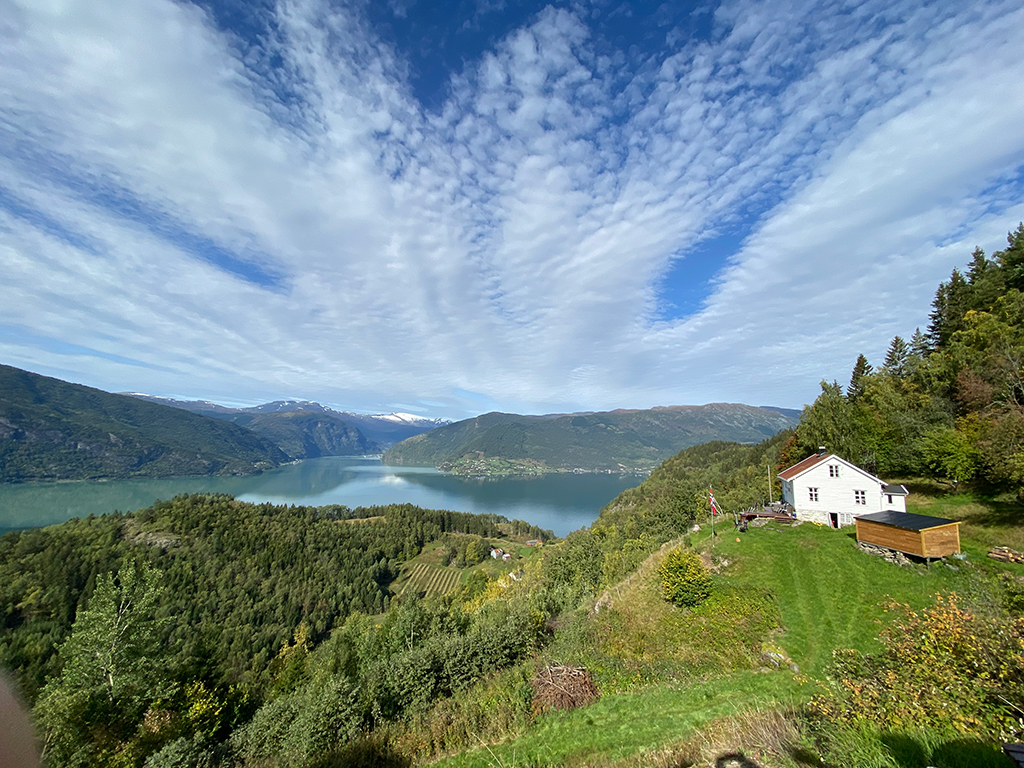
Scenic Villages Along Sognefjord
The fjord is dotted with picturesque villages like Flåm and Balestrand, each offering unique experiences and stunning views. These villages serve as perfect starting points for exploring the fjord. Flåm is known for its scenic railway, which offers breathtaking views of the fjord and the surrounding mountains. Balestrand is famous for its beautiful wooden villas and its rich artistic heritage. Both villages offer a range of accommodation options, from cozy guesthouses to luxury hotels.
Popular Activities
From scenic cruises to adventurous hikes, Sognefjord offers a wide range of activities. Visitors can also explore the fjord by kayak or take a ride on the famous Flåm Railway. Cruises are a great way to see the fjord, with many options available, from short day trips to multi-day excursions. Hiking trails in the area offer stunning views and a chance to explore the surrounding mountains. The Flåm Railway is one of the most scenic train journeys in the world, offering breathtaking views of the fjord and the surrounding landscape.
Best Seasons to Visit Norway’s Fjords
Summer (June to August)
Weather and Temperatures
Summer is the most popular time to visit the fjords, with temperatures ranging from 15°C to 20°C (59°F to 68°F). The weather is mild and pleasant, perfect for outdoor activities. The long days and warm temperatures make summer the ideal time for exploring the fjords. The weather is generally stable, with plenty of sunshine and clear skies. However, it’s always a good idea to be prepared for rain, as the weather can change quickly in the fjords.
Daylight Hours and Midnight Sun
During summer, Norway experiences almost 24 hours of daylight, especially in regions north of the Arctic Circle. This phenomenon, known as the midnight sun, allows for endless exploration and adventure. The long days mean that you can pack a lot into your trip, with plenty of time for hiking, kayaking, and sightseeing. The midnight sun is a unique and magical experience, with the sun never fully setting and the landscape bathed in a soft, golden light.
Summer Activities
Summer is ideal for hiking, kayaking, and taking scenic boat tours. The long days provide ample time to explore the fjords and enjoy the stunning landscapes. Hiking trails in the area offer stunning views and a chance to explore the surrounding mountains. Kayaking is another great option, allowing you to get up close and personal with the fjord’s natural beauty. Boat tours are a popular way to explore the fjord, offering a unique perspective on the landscape. The warm weather and long days make summer the perfect time for outdoor activities.
Spring (May to June)
Blooming Orchards and Scenic Beauty
Spring is a great time to visit if you want to avoid the summer crowds. The fjords come alive with blooming orchards, especially around Hardangerfjord, creating a picturesque setting. The blooming fruit trees add a splash of color to the landscape, with pink and white blossoms contrasting with the deep blue of the fjord. The air is filled with the sweet scent of flowers, creating a magical and romantic atmosphere.
Avoiding the Crowds
Spring offers a more peaceful experience, with fewer tourists and quieter trails. It’s the perfect time to enjoy the natural beauty of the fjords without the hustle and bustle of peak season. The weather is generally mild, with temperatures ranging from 10°C to 15°C (50°F to 59°F). The days are getting longer, with plenty of daylight for exploring. Spring is a great time to visit if you prefer a quieter and more relaxed experience.
Autumn (September to October)
Autumn Colors and Mild Weather
Autumn brings a burst of color to the fjords, with vibrant foliage and mild temperatures. It’s a beautiful time to visit, offering a different perspective on the landscape. The trees turn shades of red, orange, and yellow, creating a stunning contrast with the deep blue of the fjord. The weather is generally mild, with temperatures ranging from 10°C to 15°C (50°F to 59°F). The days are getting shorter, but there is still plenty of daylight for exploring.
Shorter Days and Cozy Evenings
While the days are shorter in autumn, the evenings are cozy and perfect for relaxing by a fire. It’s a great time to enjoy the tranquility of the fjords and take in the stunning autumn scenery. The shorter days mean that you can enjoy the beautiful sunsets and the soft, golden light of the evening. The cooler temperatures make it the perfect time to enjoy a hot drink by the fire and relax after a day of exploring.
The Importance of Sunshine in Norway
The Midnight Sun Phenomenon
Best Regions to Experience the Midnight Sun
The midnight sun is best experienced in regions north of the Arctic Circle, such as Tromsø and the Lofoten Islands. These areas offer endless daylight during the summer months. The midnight sun is a unique and magical experience, with the sun never fully setting and the landscape bathed in a soft, golden light. It’s a surreal experience that you won’t find anywhere else.
Activities Under the Midnight Sun
The extended daylight hours allow for unique activities like midnight hikes, late-night fishing, and even golfing under the sun. It’s a surreal experience that you won’t find anywhere else. The midnight sun allows you to pack a lot into your trip, with plenty of time for hiking, kayaking, and sightseeing. The long days mean that you can explore the fjords at your own pace, without having to worry about running out of daylight.
Winter in Norway
Short Days and Limited Daylight
Winter in Norway is characterized by very short days, especially in the north. The limited daylight can be a challenge, but it also offers a unique and serene experience. The short days mean that you can enjoy the beautiful sunsets and the soft, golden light of the evening. The cooler temperatures make it the perfect time to enjoy a hot drink by the fire and relax after a day of exploring.
Winter Activities and Attractions
Despite the short days, winter is a great time to visit for activities like skiing, dog sledding, and experiencing the northern lights. The fjords take on a magical quality in the winter, with snow-covered landscapes and frozen waterfalls. The northern lights are a highlight of any winter trip to Norway, with their stunning displays of color and light. Skiing and dog sledding are also popular activities, offering a unique and exciting way to explore the fjords.
Additional Insights from Travel Experts
Skyhook Adventure’s Recommendations
Skyhook Adventure confirms that summer is the best time to visit the fjords due to the mild weather and long daylight hours. They recommend taking advantage of the extended days to explore as much as possible. The long days mean that you can pack a lot into your trip, with plenty of time for hiking, kayaking, and sightseeing. The mild weather makes it the perfect time for outdoor activities, with plenty of sunshine and clear skies.
Thrifty Traveler’s Tips
Thrifty Traveler highlights that summer provides the best weather and long days, with the sun setting very late. They suggest planning your activities to make the most of the extended daylight. The long days mean that you can explore the fjords at your own pace, without having to worry about running out of daylight. The mild weather makes it the perfect time for outdoor activities, with plenty of sunshine and clear skies.
Responsible Travel’s Advice
Responsible Travel notes that while the fjords are accessible year-round, the coldest months are December to February. They recommend visiting in the summer for the best experience. The mild weather and long days make summer the ideal time for exploring the fjords. The weather is generally stable, with plenty of sunshine and clear skies. However, it’s always a good idea to be prepared for rain, as the weather can change quickly in the fjords.
Lonely Planet’s Seasonal Guide
Lonely Planet recommends summer for fjords, hiking, and festivals, while winter is best for experiencing the northern lights and polar night. They provide a comprehensive guide to the best times to visit. The long days and warm temperatures make summer the ideal time for exploring the fjords. The weather is generally stable, with plenty of sunshine and clear skies. However, it’s always a good idea to be prepared for rain, as the weather can change quickly in the fjords.
Fjords and Beaches’ Top Picks
Fjords and Beaches emphasize that summer is the prime time to visit the fjords, with the Lofoten Islands, Stavanger, and other regions being top picks. They suggest exploring these areas for the best fjord experiences. The long days and warm temperatures make summer the ideal time for exploring the fjords. The weather is generally stable, with plenty of sunshine and clear skies. However, it’s always a good idea to be prepared for rain, as the weather can change quickly in the fjords.
Conclusion: The Best Time to Visit Norway’s Fjords
Summary of Optimal Seasons
In conclusion, the best time to visit Norway’s fjords is during the summer months for optimal weather and extended daylight. However, spring and autumn also offer unique and beautiful experiences. The long days and warm temperatures make summer the ideal time for exploring the fjords. The weather is generally stable, with plenty of sunshine and clear skies. However, it’s always a good idea to be prepared for rain, as the weather can change quickly in the fjords.
Final Travel Tips
When planning your trip, consider the activities you want to do and the type of experience you’re looking for. Whether it’s the endless days of summer or the cozy evenings of autumn, Norway’s fjords offer something for everyone. The long days and warm temperatures make summer the ideal time for exploring the fjords. The weather is generally stable, with plenty of sunshine and clear skies. However, it’s always a good idea to be prepared for rain, as the weather can change quickly in the fjords.

